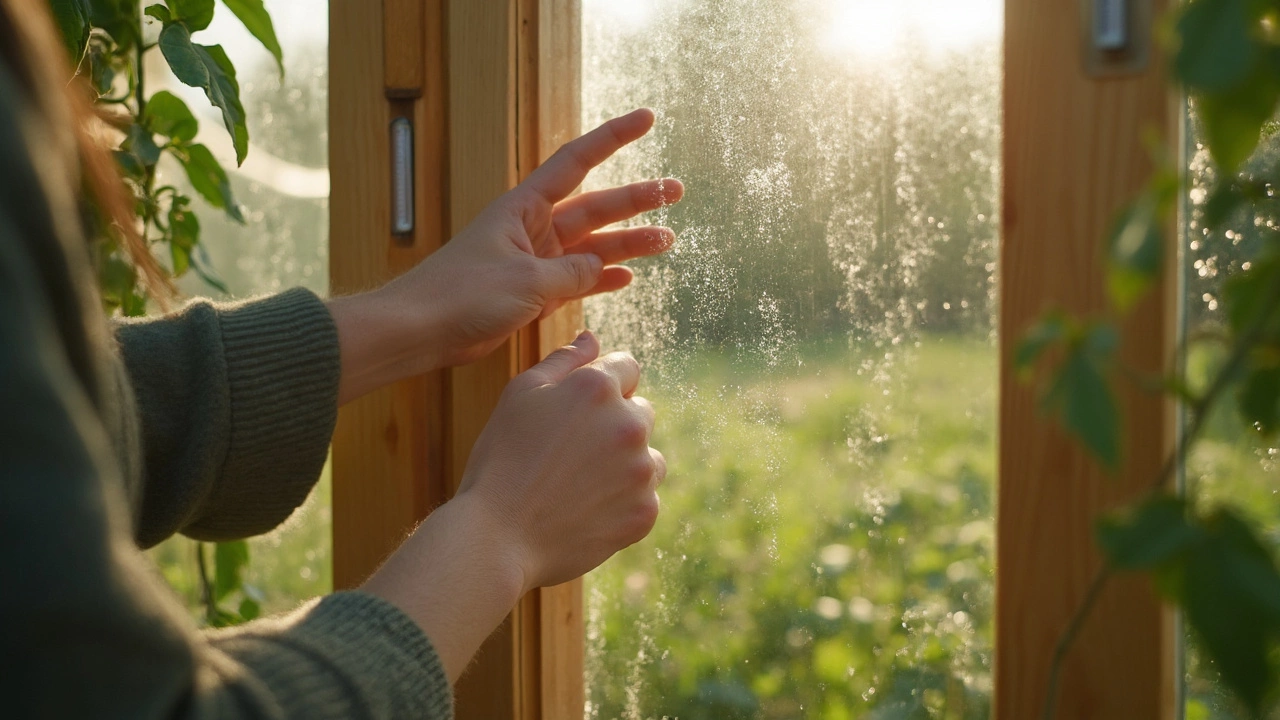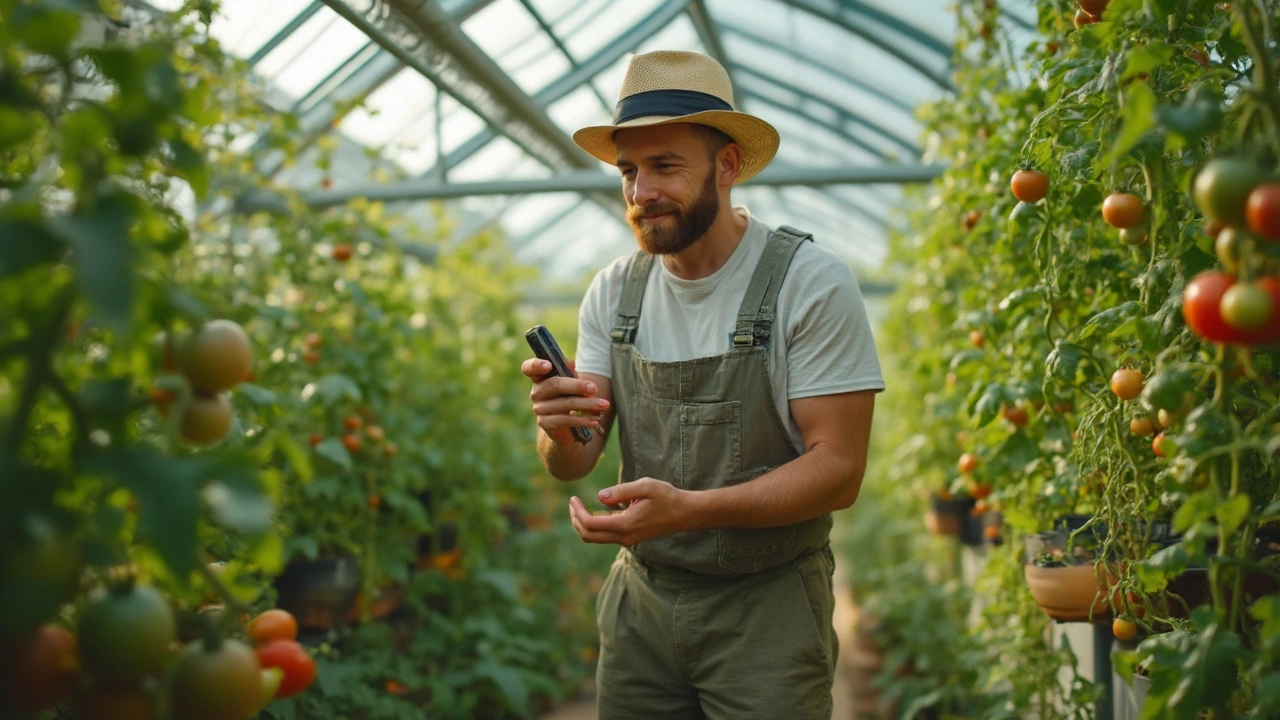Tomatoes can get seriously toasty inside a greenhouse, even if it’s not blazing hot outside. In the UK, those sudden sunny spells can turn your glasshouse into a baking oven before you’ve even had your first cuppa. Thing is, tomatoes actually get stressed when the heat cranks up too much—so you can’t just ignore it and hope they’ll tough it out.
If you’ve ever seen your tomato leaves going floppy, or the flowers just dropping off for no good reason, it’s probably not pests or dodgy compost. Nine times out of ten, it’s heat. When it rises above 27°C (that’s about 80°F), the plant starts struggling to set fruit. Above 32°C (around 90°F), you can see leaves curling, pale patches, and fruit that tastes a bit flat or even goes weirdly mealy.
The good news? There’s loads you can do to keep things steady. Forget fiddly gadgets or spending loads—sometimes all it takes is opening the vents earlier than you think, or even cracking the greenhouse door at the crack of dawn. Later, we’ll get into cheap shade tricks, watering tips that actually work, and why I once caught my cat Snowball fast asleep right by the open louvre—proof even pets know where the cool spot is.
- Why Tomatoes Heat Up Fast Inside Greenhouses
- Warning Signs Your Tomatoes Are Too Hot
- How to Cool Things Down—Simple Tricks That Work
- Getting the Balance Right for Healthier Tomatoes
Why Tomatoes Heat Up Fast Inside Greenhouses
Ever notice how your greenhouse feels like a sauna on sunny days, even in classic UK drizzle season? That’s not just your imagination. Glass or plastic panels trap heat from sunlight—basically, the greenhouse works like a giant radiator. Sun pours in, bounces around, and doesn’t escape, causing a fast rise in temperature. Tomatoes are in the thick of it, getting warm from every direction.
Here’s the thing: greenhouses don’t just hold heat, but also block wind. It sounds cosy for young plants, but once summer days hit, there’s zero breeze to cool things down. In the open, tomatoes get a natural break from the sun as clouds roll in or a wind gusts by. In a greenhouse? No chance—it’s just relentless heat unless you step in.
Humidity gets sneaky too. With all the watering and closed spaces, greenhouses build up loads of moisture. High humidity and heat together make it harder for tomatoes to cool themselves by releasing water from their leaves. That’s when leaves start to curl, and you end up with fruit that won’t ripen properly because the plant is in defence mode.
- Glass heats up quicker than plastic, so traditional glass greenhouses can get stifling faster than those newer polycarbonate versions, especially if you forget to ventilate.
- Direct sunlight through clean panels speeds up heating—think of it like parking your car in full sun with the windows up.
- UK weather can flip from grey clouds to a full sunburst in minutes, so a greenhouse that felt fine in the morning may be roasting by lunchtime.
The greenhouse gives you a head start with your tomatoes, but it comes with a catch—you have to stay one step ahead, or that warm and cosy space turns into a tomato sauna fast.
Warning Signs Your Tomatoes Are Too Hot
When things start heating up in the greenhouse, tomatoes don’t hide their discomfort—they show it. If you spot droopy leaves in the middle of the day, don’t rush for the watering can. Tomatoes sometimes wilt as a heat survival trick and then perk up when things cool down. If leaves stay limp and sad into the evening, it’s usually a sign of real trouble.
Another big red flag? Flower drop. Tomatoes need the right conditions to turn flowers into juicy fruit. If the air inside your greenhouse regularly climbs past 27°C (that’s about 80°F), your plants might drop their flowers before any fruit has a chance to form. That means you’re working hard for nothing, and no one wants empty trusses at the end of July.
Other symptoms pop up if the heat sticks around:
- Leaf edges looking brown or crispy, almost burnt
- Pale yellow patches on the fruit, called sunscald
- Curling or rolling leaves (especially upwards at the sides), which is the plant’s way of reducing water loss
- Fruit that’s mealy or watery when you eat it—nowhere near as tasty as it should be
Keep an eye on the mercury too. Here’s a quick cheat-sheet for when to worry:
| Temperature (°C) | What Happens to Tomatoes? |
|---|---|
| 24-26 | Optimum for fruit set; growing well |
| 27-29 | Flower drop starts; fruit set drops |
| 30+ | Leaves wilt, fruit quality suffers, sunscald risk jumps |
The greenhouse can turn harsh fast in sunny spells, especially with our unpredictable UK weather. That's why most growers recommend checking how things look in the middle of the afternoon, not early morning. If your tomatoes look rough, don’t panic—skip the assumptions and go straight to the clues above. Sort early, and you’ll stop a simple heatwave turning into a ruined tomato season.

How to Cool Things Down—Simple Tricks That Work
Beating the heat in a greenhouse isn’t rocket science. Most fixes are way easier than people think. Let’s start with air: tomatoes need a regular breeze, not a sauna. I always crack the vents open before it gets warm. Side vents make a big difference. If your greenhouse only has roof vents, prop the door open on hot mornings, but make sure the cat doesn’t sneak in and knock over your seed trays like Snowball did to us last summer.
Adding shade is a game-changer. Even a cheap bit of shade netting, old bed sheet, or garden fleece pegged over the sunny side of the glass drops temps by a few degrees. Commercial shade nets often block 30–50% of the sunlight, which is spot on for tomatoes in a UK glasshouse. Just don’t smother them completely—tomatoes still need strong light to ripen.
Don’t let hot air and dry soil gang up on your tomatoes. Water deeply first thing in the morning and, on really hot days, think about a second light watering early afternoon. Keeping the floor damp (not flooded) with a watering can also cools the air as the water evaporates. If you’re forgetful (like me), set a reminder—once plants start drooping, stress has already kicked in.
Here are a few easy tricks that work even if you’re busy:
- Hang an inexpensive thermometer at plant height so you spot trouble early.
- Open vents before 9am when sun is on the rise, not after things are already roasting.
- Use a small fan if you can run power to your greenhouse—moving air means cooler plants.
- Paint the outside of the glass with special greenhouse shading paint, especially during heatwaves. It washes off with autumn rain.
For a quick look at what works for keeping temperatures in check, here’s a comparison of simple cooling tricks and how much temperature drop you’ll likely get inside your greenhouse on a sunny UK day:
| Cooling Method | Average Temp Drop | Extra Notes |
|---|---|---|
| Vent Opening | 3–7°C | Open both roof and side vents early |
| Shade Netting | 4–8°C | Use 30–50% shading, keep it just above the plants |
| Damping Down (water floor) | 2–4°C | Best in dry, hot spells |
| Greenhouse Shading Paint | 5–10°C | Wash off after summer |
None of these fixes cost a fortune and every one helps your greenhouse tomatoes stay healthy, even when the mercury shoots up. I’ve tried most with my own lot, and honestly, it’s made all the difference between tomatoes that sulk and tomatoes that thrive.
Getting the Balance Right for Healthier Tomatoes
Letting your tomatoes get too hot in the greenhouse can tank your crop, but it’s just as easy to overcorrect and leave them cold or soggy. What you want is that sweet spot: plenty of warmth, good airflow, and no wild swings in temperature or moisture. Here’s how you can hit that balance without losing your mind (or your tomatoes).
First, keep a simple thermometer—or, even better, a max-min thermometer—inside the greenhouse. This tech lets you track temperature swings. Tomato plants do best with daytime temps between 21°C and 27°C (70–80°F) and slightly cooler at night. If the daytime heat regularly climbs above 32°C (90°F), you’ll see stunted growth and fruit problems.
| Condition | Too Cold | Just Right | Too Hot |
|---|---|---|---|
| Day Temp | Below 18°C | 21–27°C | Above 32°C |
| Night Temp | Below 13°C | 15–18°C | Above 23°C |
| Fruit Quality | Bland, slow ripening | Full flavour, firm | Mealy, tasteless |
If you notice things getting too hot, ventilation is your main tool. Open roof vents and doors early in the day—don’t wait until the greenhouse is roasting. If you have automatic vent openers, make sure they actually work (I’ve lost count of the times mine stuck until I gave them a nudge). For extra hot spells, hang up some old net curtain or buy cheap shade cloth; even 40% shading makes a big difference.
Tomatoes need consistent watering. Too dry and they’ll wilt or crack. Too wet and they get root rot, or the fruit splits. Water at the roots early in the day and try to keep leaves dry—it helps prevent disease. Investing in a basic drip system or setting some bottles with holes in the soil can even out moisture when you’re busy or away for a weekend.
- Use a cheap max-min thermometer to track greenhouse highs and lows.
- Vent your greenhouse before it feels hot; early morning is better than midday.
- Hang lightweight shade cloth or even fleece to knock back midday sun.
- Water soil, not leaves, and do it first thing in the morning for best results.
Don’t forget humidity. Tomato plants thrive at 60–70% humidity, but UK greenhouses often get muggy once you water. A bit of airflow helps—point a fan towards the plants, or just wedge the door open safely. My kids, Marlon and Esme, love checking humidity with a cheap digital sensor and racing to see who finds the big numbers first—turns out kids are just as competitive as tomatoes about growing right!
The trick isn’t perfection. You want steady conditions—consistent warmth, even moisture, not too stuffy or dry. Stick to these basics, and you’ll get strong plants, better fruit, and way fewer headaches come August. The best part? You don’t need fancy gear. A watchful eye and some quick fixes give tastier, healthier tomatoes every time.
